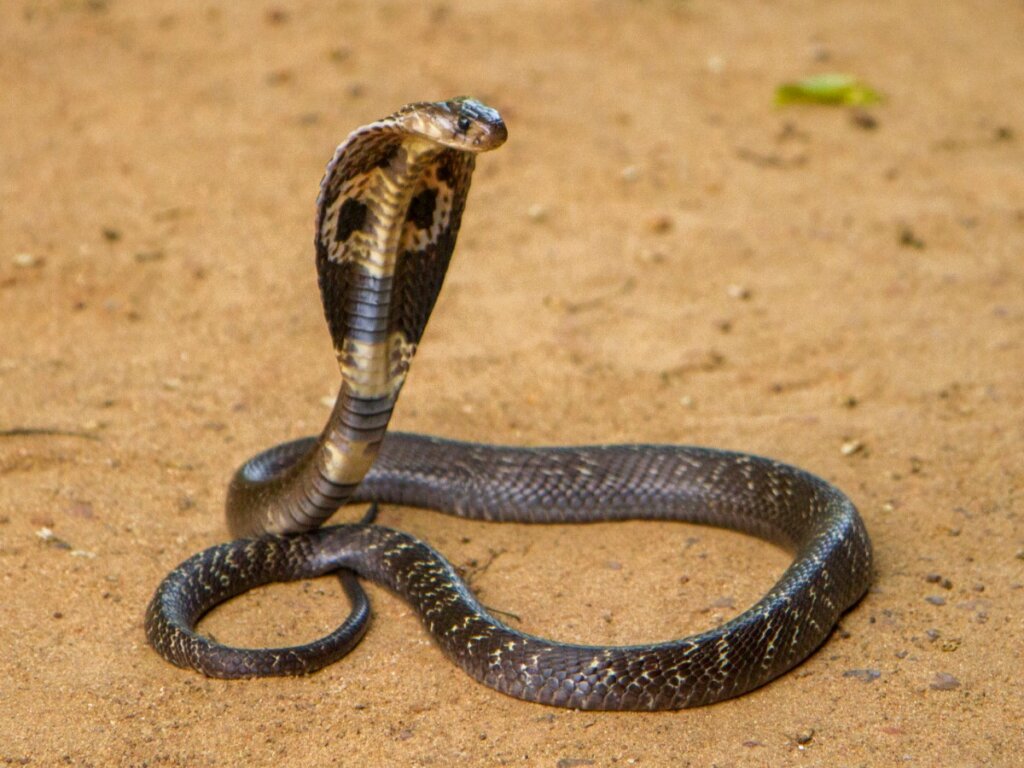9 of the Deadliest Snakes
The deadliest snakes aren’t always the ones that attack. In fact, none of them attack for pleasure, but because they feel under mortal threat. Even so, accidents do happen, and, in the case of the snakes, you’re about to see that it doesn’t usually have a happy ending.
Despite this, many people are fascinated by venomous snakes and devote themselves to studying them. Part of this study is also due to the fact that the toxins carried by many of these reptiles can be used for human medicine. Would you like to know all about the deadliest snakes in the world?
The deadliest snakes in the world
Many snakes are capable of killing humans (and much larger animals). Encountering one of them should always be a reason to stay away, because you don’t know when you might be bothering them. Let’s take a look at the deadliest ones.
1. Black mamba (Dendroaspis polylepis)
The name of this snake comes from the color of the inside of its mouth, which is bluish-black. The toxin inoculated by the black mamba is neurotoxic, that is, it affects the nervous system and causes paralysis of the muscles. As the venom spreads through the body, the paralysis can affect the heart and lungs, resulting in death.
The black mamba, which inhabits central and southern Africa, frequents areas of tall grass, so accidents with humans entering these areas are common.
2. Coral snake
Native to tropical areas of the Old and New World, this family of snakes includes 99 species, all of which are brightly colored to warn of their potent neurotoxic venom. The real danger is the absence of any marks when it bites: there’s no inflammation or pain until after 12 hours, which is when the venom begins to affect muscles and nerves.
3. Central American bushmaster (Lachesis stenophrys)
This viper is among the largest snakes in the world, as it can exceed 3 meters (10 feet) in length. Its venom is proteolytic (destroys proteins), anticoagulant, and hemotoxic (destroys blood cells).
However, this same venom is used to produce antivenom for 17 other snake species in Central America. This is why there’s a fight for their conservation, as the destruction of their habitat, their extraction for collections, and extermination are killing them.
4. Boomslang (Dispholidus typus)
This green and yellowish snake can be found all over Africa. Its retractable fangs allow it to bite more than once and its hemotoxic venom produces external and internal hemorrhages, bleeding the victim.
5. Russell’s viper (Daboia russelii)
This viper is one of the deadliest snakes in the world, according to a study published in the journal Toxins. It usually rests in rice paddies, so accidents in Sri Lanka (its place of origin) are very common and people who are bitten often die from kidney failure.
The venom of the Russell’s viper is hemotoxic, and can cause both severe hemorrhages and strokes due to clot formation.
6. Black-necked spitting cobra (Naja nigricollis)
The venom of this Central African cobra combines neurotoxins with cytotoxins, which are those that cause cell death and, therefore, tissue necrosis. It’s named for its ability to shoot venom at a distance of up to 3 meters (10 feet).
7. Gaboon viper (Bitis gabonica)
This is the largest snake of the genus Bitis and one of the deadliest snakes of all. It also holds a record: it’s the snake with the largest fangs in the world, reaching up to 55 millimeters (2.1 inches). The venom of the Gaboon viper is hemotoxic and it is one of the fastest and most precise ophidians when it comes to capturing its prey.
8. Inland taipan (Oxyuranus microlepidotus)
This species of snake inhabits the arid outback regions of Australia. Although it rarely comes into contact with humans, its bite is deadly to our species, as it contains the enzyme hyaluronidase, which increases the rate of absorption of toxins into the prey’s body.
9. King cobra (Ophiophagus hannah)
This, besides being one of the deadliest snakes, is also one of the most aggressive. And this is no coincidence, since its diet is based exclusively on other snakes. To hunt another snake you cannot be docile!
It’s the longest snake in the world, measuring up to 5.4 meters (nearly 18 feet) in length.
In addition, its venom is neurotoxic and cardiotoxic, affecting the central nervous system of its prey, killing them by heart failure or respiratory paralysis. The young possess venom from birth.
Although the thought of encountering one of these reptiles may seem horrific, the truth is that, except for the Russell’s viper, they don’t usually have many encounters with humans. Even so, many snakes are decreasing in number due to human action, and so we could ask ourselves who is the most lethal?
It might interest you...All cited sources were thoroughly reviewed by our team to ensure their quality, reliability, currency, and validity. The bibliography of this article was considered reliable and of academic or scientific accuracy.
- Hodgson, W. C., Dal Belo, C. A., & Rowan, E. G. (2007). The neuromuscular activity of paradoxin: a presynaptic neurotoxin from the venom of the inland taipan (Oxyuranus microlepidotus). Neuropharmacology, 52(5), 1229-1236.
- Bickler, P. E. (2020). Amplification of snake venom toxicity by endogenous signaling pathways. Toxins, 12(2), 68.
- Senji Laxme, R. R., Khochare, S., Attarde, S., Suranse, V., Iyer, A., Casewell, N. R., … & Sunagar, K. (2021). Biogeographic venom variation in Russell’s viper (Daboia russelii) and the preclinical inefficacy of antivenom therapy in snakebite hotspots. PLoS neglected tropical diseases, 15(3), e0009247.
- Damm, M., Hempel, B. F., & Süssmuth, R. D. (2021). Old World Vipers—a review about snake venom proteomics of Viperinae and their variations. Toxins, 13(6), 427.
- Ferraz, C. R., Arrahman, A., Xie, C., Casewell, N. R., Lewis, R. J., Kool, J., & Cardoso, F. C. (2019). Multifunctional toxins in snake venoms and therapeutic implications: from pain to hemorrhage and necrosis. Frontiers in ecology and evolution, 7, 218.
